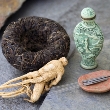Kampo
Kampo
Natural Standard Monograph, Copyright © 2013 (www.naturalstandard.com). Commercial distribution prohibited. This monograph is intended for informational purposes only, and should not be interpreted as specific medical advice. You should consult with a qualified healthcare provider before making decisions about therapies and/or health conditions.
Related Terms
Acupuncture, Kampo, moxa, moxibustion, traditional Chinese medicine (TCM), traditional Japanese medicine.
Background
Kampo is a Japanese thought and treatment system of illness. Kampo developed after traditional Chinese medicine (TCM) was brought to Japan from China in the 4th or 5th century. "Kampo" is the pronunciation of two Chinese characters. The kan (han) character means "from China," and po (ho) means "way."
Although Kampo shares some aspects with TCM, it is a separate system of herbal combinations, forms of acupuncture, and moxibustion. Kampo has a vibrant history of books and manuscripts written by experts about this form of medicine; the published history of Kampo spans ancient times till today.
One practice is moxibustion, which is the burning of herbs on or near acupuncture points. Kampo uses this method more than TCM. The role of moxibustion in Kampo has grown in importance and the government now issues a license just for moxibustion over acupuncture points.
Today, Kampo is integrated into the mainstream Japanese healthcare system. Herbal combinations are manufactured under strict government supervision and laws that are as stringent as for pharmaceuticals. Since 1967, the Japanese Ministry of Health, Labour and Welfare has authorized 148 Kampo formulas to be prescribed and covered to patients under the nationalized health plan. Kampo is a very popular treatment in Japan today. For example, more than 1.5 million patients take the Kampo herbal formula Sho-saiko-to for hepatitis B and C, according to Alan Glombicki, MD, an Associate Professor of Clinical Medicine at the University of Texas.
Theory/Evidence
Research on Kampo in Japan is conducted according to a different system of proof and evidence than in Western-style randomized control trials. Japanese-style research focuses on the predicament of people with particular "constitutions", and often separates trial groups by a series of signs and symptoms for which there is no correlate in Western medicine. Kampo has been proven an effective form of treatment in Japan by means of this other testing system.
Western-style research on various Kampo herbal formulas is still in their infancy. Today the US government funds research in this promising form of alternative medicine through the National Center for Complementary and Alternative Medicine, and many prominent universities, including Harvard Medical School, host institutes dedicated to exploring this and other Eastern medical traditions.
Author Information
This information has been edited and peer-reviewed by contributors to the Natural Standard Research Collaboration (www.naturalstandard.com).
Bibliography
Natural Standard developed the above evidence-based information based on a thorough systematic review of the available scientific articles. For comprehensive information about alternative and complementary therapies on the professional level, go to www.naturalstandard.com. Selected references are listed below.
Japanese Ministry of Health, Labour and Welfare. 10 May 2006. http://www.mhlw.go.jp/english/index.html
Kenner, D. August 2001. Research in Japanese Botanical Medicine and Immune Modulating Cancer Therapy - Kampo. Townsend Letters for Doctors and Patients. 10 May 2006. http://www.findarticles.com/p/articles/mi_m0ISW/is_2001_August/ai_78177216/pg_2
National Center for Complementary and Alternative Medicine. 10 May 10, 2006. http://nccam.nih.gov/
Osher Institute at Harvard Medical School. 10 May 10, 2006. http://www.osher.hms.harvard.edu
Copyright © 2013 Natural Standard (www.naturalstandard.com)
The information in this monograph is intended for informational purposes only, and is meant to help users better understand health concerns. Information is based on review of scientific research data, historical practice patterns, and clinical experience. This information should not be interpreted as specific medical advice. Users should consult with a qualified healthcare provider for specific questions regarding therapies, diagnosis and/or health conditions, prior to making therapeutic decisions.
Updated:
March 22, 2017
